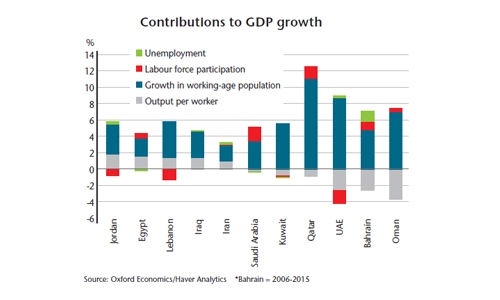Bahrain productivity in declining trend
Manama: Productivity in the region including Bahrain is showing declining trend, thanks to the diversification of work force into non-oil sectors, according to a recent
report.
According to the report by Oxford Economics, as Middle East economies continue diversifying into less capital intensive sectors and governments prioritise job creation, it seems likely the trade-off between employment growth and headline productivity growth will continue to tilt towards the former.
The report suggests that productivity should be analysed very subjectively taking into account the peculiarities of the region.
“Certainly, a focus on output per worker that fails to account for wider sectoral and labour force rebalancing would be misleading. But raising the productivity of individual workers – by increasing their access to capital, their skills and the competitive environment in which they work – is still crucial,” the report said.
The region’s productivity performance in recent years is not encouraging. Between 2002 and 2015, productivity growth typically contributed between 1–2 percentage points (pp) towards annual GDP growth in Jordan, Egypt and Lebanon, close to zero in Iran, Saudi Arabia and Qatar, and made a negative contribution in many other Middle Eastern economies.
By contrast, output per worker contributed 1.5pp in Singapore and 4pp in Vietnam per year over the same period, according to Oxford Economics.
The oil –extraction-sector productivity on its own shows high value and the recent focus of weaning away the economy from oil dependence is pressurizing the productivity figures.
“The importance of extraction in Middle Eastern economies can skew productivity comparisons in two ways. Firstly, a fall in productivity in extraction can lower productivity measured at the whole economy level. Secondly, as employment opportunities are generated in non-extractive sectors, this will lower the overall level of output per worker, ” the report stated.
Thus, even if non-oil sectors individually have rising productivity, the pace of diversification away from the highly productive extractive sector may be sufficient to lower whole economy productivity.
The female employment has also been creeping up in many sectors.
It added, “Increased female employment is clearly positive in the wider perspective of diversity and better use of countries’ labour forces. Interestingly, survey evidence suggests that women are increasingly targeting higher value-added service sectors such as banking and financial services.”
Oxford Economics noted that increased female employment in turn boosts overall GDP growth, household incomes and tax receipts from non-oil sources.
“Other things being equal, these trends lower average output per worker versus a ‘status quo’, even as they support ongoing improvements in living standards, approximated by GDP per head growth.”
Overall, the performance of Middle Eastern economies in raising output per worker has been slower than other parts of the world economy when comparing simple average rates of growth. Yet this obscures many structural movements within the region’s economies – diversifying into new sectors, accommodating an expanding workforce to achieve this and increasing female participation, the report said.
Related Posts

